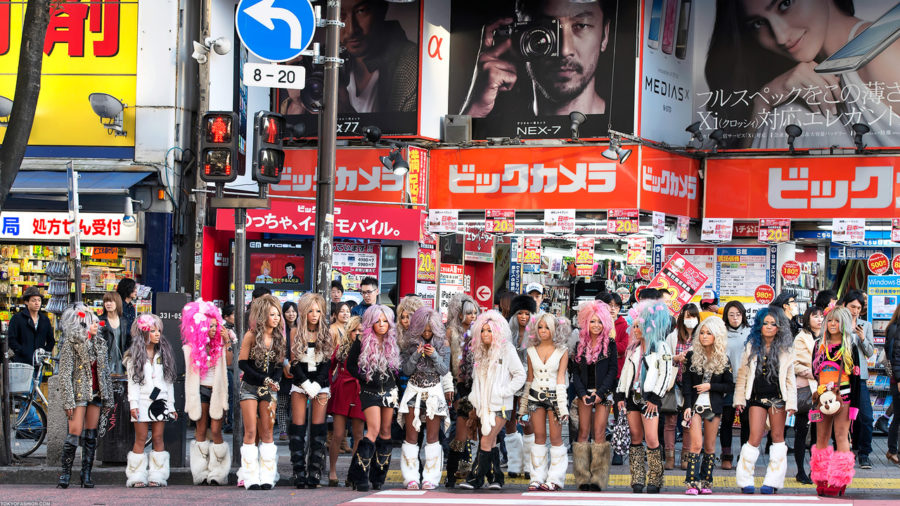The History of Gyaru- a Fashion Rebellion
Gyaru, one of the many fashion styles in Japan, created an empire of women empowerment and rebellion against traditional beauty standards- and here’s how.
Gyaru is a Japanese fashion subculture, derived from the English word ‘Gal.’ This fashion was originally created in the 1970’s as a retaliation against Japan’s harsh beauty standards for teenage girls, and it reached its peak in the late 90’s and the early 2000’s, but what is the lifestyle of these ‘Gals,’ and how has this style evolved over time?
The word ‘Gyaru’ started becoming popular in the 70’s and 80’s, mainly seen in magazines. The meaning of Gyaru, and the interchangeable ‘Gal,’ changed in 1989 when Yutsuko Chuusonji, a popular artist and author at the time, released a manga called ‘Sweet Spot’, popularizing the term ‘Oyaji Gyaru,’ or ‘Old man Girl.’ In the early 90’s, Teamers, who were described as anti-social, delinquent teenagers, started going to Shibuya at night. Their style and attitude took inspiration from American gangs and popular American styles. They helped to build the ‘Shibuya Casual’ style, or the ‘ShibuKaji’. This paved the way for the beginnings of Kogal a few years later in 1993.
Kogal, now known to be a popular substyle in Gyaru, had prominent elements like tanned skin, bleached hair, and loose socks. This style was seen in many schoolgirls, wearing shorter skirts and accessorized uniforms and school bags. Kogal continued to develop into 1996, peaking with the solo debut of singer Namie Amuro.
Amuro’s clothing style influenced many young girls, nicknamed ‘Amuraa,’ or ‘Amurer.’ Amurer girls liked photo booths, the party lifestyle, and had a high-spirited personality. The style’s staples were light brown hair, plaid or blueberry prints, mini skirts, and platform boots. Cawaii! Magazine, launched in March 1996, familiarized the public with street photography and teen fashion magazines.
Around the same time, from 1994-1998, there was a surge in ‘Loco Gals,’ or ‘Local girls.’ The term ‘Loco’, coming from the English word ‘Local’, means a girl who was born and raised in Hawaii. Similar to Amuraa, this style was also described my free-spirited girls, but Loco Gals were also known to love nature. They also had tans, wearing hibiscus patterns and other beach clothing, while also taking elements from the original Kogal and Amuraa styles.
Around this time, another substyle appeared, ‘Ganguro’. This style held some elements from Kogal, like the bleached hair, dark tans and platform boots. However, Ganguro not only emphasized a darker tan, but also white makeup around the eyes and on the lips.
Just a year later, in 1999, the largely popular egg magazine would shift its focus and heavily feature Gyaru teenage models. Along with the surge in popularity of egg magazine came another substyle- Yamamba Gyaru, a substyle based off of the original Ganguro style. With each issue of egg magazine, Gyaru would grow and evolve rapidly.
Getting into the early 2000’s, the popularity of Gyaru continued to soar as egg magazine got more popular. In 2006, a new Gyaru magazine surfaced, Ageha Magazine. This magazine highlighted the Agejo style, a hyer-feminine style, mainly worn by older Gals due to its more mature elements. This glamorous style would become not only the staple at the time, but it would go on to become one of the more popular substyles of Gyaru today.
Entering the 2010’s, Gyaru is at its peak. Many well-known Gyaru models start their own clothing brands, and more magazines start to market towards these younger audiences. However, many Gyaru’s had abandoned more extravagant styles and gone for a more toned down look, using pastel pinks and earthy tones. This style and era of fashion has often been related to Roma Gyaru, which was a style to come later in 2013.
Roma Gyaru replaced many older styles, and as they died out from the magazines, many stopped wearing those styles. With this loss of interest in Gyaru, many magazines would stop publication during this time, including egg and Ageha. This sudden drop in the publication of Gyaru styles greatly contributed to the downfall of the style, and the Gyaru style started adapting to Japan’s beauty standards, switching out the dark tans and blonde hair to light makeup and darker hair. This was known as Shiro Gyaru, taking modern trends and giving them a Gal makeover.
Luckily, the later half of the 2010’s had a rise in this new style, and both egg and Ageha would come back into publication, serving looks from this new Shiro Gyaru substyle. Luckily, with the return of egg magazine was new egg models, and many brought back the blonde hair, long nails, and fashion interest that were core elements of the original Gyaru style.
If one were to walk the streets of Shibuya today, it’s still possible to find these Gals. Gyaru might not be as popular as it was in the past decades, but its effect on Japanese fashion has not been forgotten, and you will still find modern-day Gals embracing both the fashion and the lifestyle of the original Gyaru girls.



